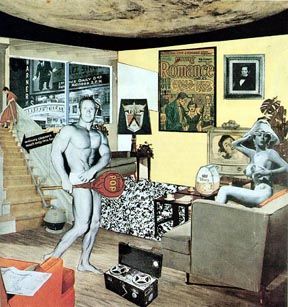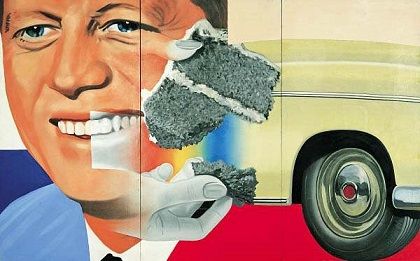Summary of Isabel Oliver
Isabel Oliver Cuevas was rediscovered in 2015 for her Spanish Pop art work, included in the exhibition The World Goes Pop at the Tate Modern in London, England. Oliver is associated with Spanish pop through her collaboration with the artist collective Equipo Crónica (Chronicle Team), founded in Valencia in 1964 by Rafael Solbes, Manuel (Manolo) Valdés (1942), and Joan Antoni Toledo. They invited Oliver to join them in 1971, when Pop art and the so-called New Figuration was influencing the work of the group.
Oliver collaborated with the Team for four years and, around the same time, she produced the important The Woman series from 1970 to 1973. Through this series Oliver examined popular culture in relation to images of women during the last decade of Franco's regime. Representative of a younger generation of women with feminist attitudes in the seventies, she overtly expressed her political views, taking advantage of Pop art's effects and strategies. Oliver analyzed and criticized the discriminatory situation of Spanish women under Franco's dictatorship, the very political situation in which she was living and of which she was a part.
While the majority of the focus regarding Pop art has centered on American and British artists, the Spanish artist Isabel Oliver provides a good example of one of the many less recognized artists around the world who appropriated Pop art strategies and effects. Additionally, she demonstrates how artists moved beyond their critique of popular culture and sought a deeper understanding of the everyday through an archaeological examination of materials and their traces.
Accomplishments
- By manipulating mass media images, in particular from magazines, Oliver critically appropriated history and art, juxtaposed reality and societal norms, individuality and family as well as addressed stereotypes of women propagated in popular culture. These popular images allowed her to comment on the superficial normalcy that women complied with in their daily lives.
- Working on an overarching theme, such as The Woman, in a series of images allowed Oliver to represent various aspects of a women's societal, familial, and stereotypical portrayals. Seriality also mimicked the multiplicity of images generated by the mass media, and how images were repeated across different formats from magazines to television.
- By the 1990s, Oliver had left "pop" behind and engaged with the concept of time. Using new materials and new everyday objects, she excavated the layers of past and present forms of human creativity, while contemplating the future.
Important Art by Isabel Oliver
Happy Reunion
Happy Reunion focuses on a group of eleven women sitting in a living room, who laugh and converse with each other. Behind them, a transparent wall reveals surreal scenes taking place in the outside world. The same scene appears in the window to the right of the canvas. While the women are painted in muted tones, the exterior scenes are depicted in vivid and bright colors, featuring a giraffe on fire with flames burning out from its back and neck; a lake, green hills, yellow sand, and white abstract forms resembling horses. In the left corner of the foreground, a red-cloaked skeletal form appears with flowing blond hair and three hands, two skeletal and one made of flesh holding an old-fashioned hourglass that shows that time has run out.
Happy Reunion is a central image of Oliver's iconic series The Woman (1970-73), which examines different aspects of femininity in Franco's Spain. Here, the happy women in the home are presented in stark contrast to the surreal and unsettling scenes of violence and despair in the world outside. Depicted as oblivious to the dangers of the "real world" the women sit in happy ignorance ensconced in their domestic sphere, even as an unsettling figure encroaches on them. By depicting how some middle-class women shielded themselves from reality, Oliver visually draws the viewer's attention to the fake appearance of normalcy that women were expected to maintain.
The Woman series addresses such popular issues as physical appearance (beauty), childhood, and domesticity by manipulating common media generated images. Oliver used her art to make powerful feminist and political statements about the ways Spanish society repressed women during the turbulent years of General Franco's dictatorship in which this series is set.
Acrylic paint on canvas - Collection of the artist
Self-portrait of the Artist
Oliver positions her self-portrait in contrast her work Happy Reunion taken from a popular magazine. Both images of artist and middle-class women are in the same black and white tones, suggesting they were produced for the same mass media. Yet, the distance between the two images suggests a temporal difference, between present (receding into the past) and the potential future, which the artist represents.
Collection of the artist
Beauty Products
In Beauty Products, a woman with short dark hair and gray-toned skin, dressed in a pale pink long sleeve jumpsuit stands with one arm raised above her head in an arcing gesture while the other, bent at the elbow, is extended straight out from the shoulder. In her hands she holds a pink colored scarf which flows in an elaborate swirling gesture behind her. Set against a white and yellow vertical striped background, she towers above a ground filled with brightly colored beauty products, such as face powders, perfumes, soaps, and bottles of nail polish.
Many Pop artists re-purposed household products in their work to comment on commercialized society, while in Oliver's work beauty products become a vehicle for visualizing the pressure such commercial products impose on women. In Beauty Products, a woman seems to rush forward, perhaps in an effort to stay on top of the latest styles, brands, and beauty trends that appear available in a never-ending supply. Referencing the oppressive pressure placed on women to achieve the societal notions of beauty and perfection, this woman seems harried and overwhelmed in her attempt to achieve this impossible task. This work demonstrates how Pop art effects could be applied to critique any number of issues in popular culture, some even from a feminist point of view. Describing the motivations behind this work, Oliver has stated she wanted to draw attention to, "...women's struggle against discrimination in their lives and in all spheres of society."
Acrylic paint on canvas - Collection of the artist
The Family
The Family, another work from The Woman series, explores how women are defined by family life. Oliver painted a black and white snapshot of a family: from left to right, a father, a young daughter, and a young toddler-age son held in his mother's arms. All are nude, yet they are posed or their hands are strategically placed to cover their breasts and genitalia. The family portrait is obstructed by a brightly colored game board placed over the entire image. A large cross with an "x" drawn in the center divides the canvas into four quadrants. In each of the four corners is a two-ringed circle with a white center; green in the top left, yellow the top right, light blue the bottom right, and red the bottom left.
The game board, which is overlaid on the nuclear family, is the popular Spanish board game Parchís, in which the players compete in leading the pawns (game pieces) out of the nest. On one level, the board game serves as a metaphor for the game of life that a woman plays in her societally restricted familial role, following the rules along the prescribed path to its end. Looked at another way, the board game represents the common family activity of playing an entertaining game together. However, a social game of gender roles is played out beneath the surface of the board game. This family sits neither concerned by their prescribed roles, nor conveying a picture of contentment. So beneath the surface of family life: the domestic bliss that the woman especially, as mother and wife, was expected to put forth and try to maintain, is a competitive social game. A reality contradicted by media images that support the notion of female domestic bliss.
Acrylic paint on canvas - Collection of the artist
Portraits, still lifes, and landscapes (Retratos, bodegones y paisajes) The Recuperation (La Recuperación)
It is very possible that Oliver contributed to this Equipo Crónica painting, as it was created after she had joined the group. It seems to relate to her interest in the image of woman. This work critically appropriates from the Golden Age of Spanish painting the style and iconography of baroque still lifes by Sanchez Cotón, or to Goya's satirically painted old hags. It sets them in dialogue with modern everyday objects such as a soda siphon and wine glass, rendered in an anonymous, realist style. This series references these early forms of consumption and modernization in Spain as commentary on the economic and industrial development of the seventies, when the majority of people moved from rural areas to live in the city.
Acrylic on canvas and frame - Museo Nacional Centro de Arte Reina Sofia
 Ask The Art Story AI
Ask The Art Story AI















